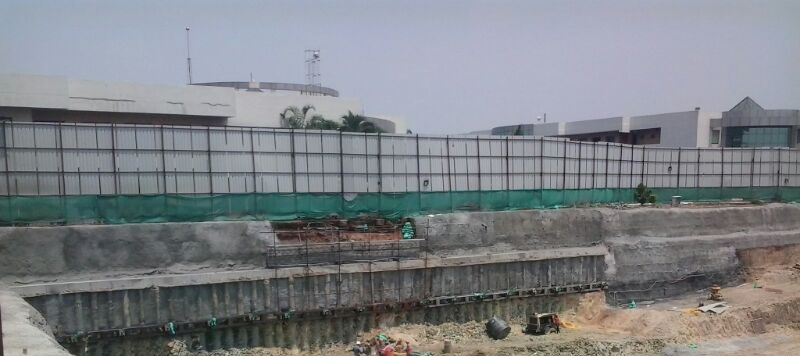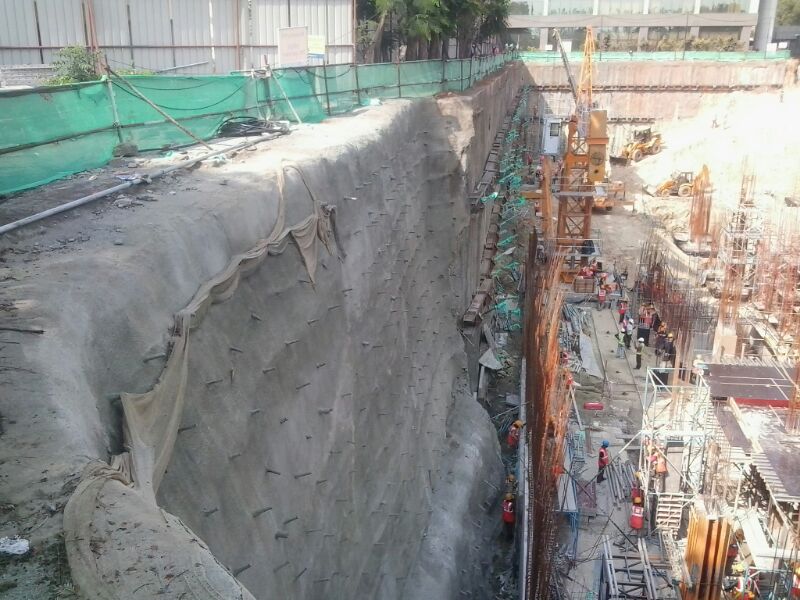What: Brief of the Problem: Global Instability Issue of Deep Excavation of 3 Stored Basement.
Geology: – Peninsular gneiss covers a significant portion of the study area and is highly
migmatitic in nature. Their composition varies from tonalite and trondhjemite to granodiorite
and has fine to medium-grained texture. They are fine to medium-grained and generally grey
in color. In some places, they are regularly banded with alternate bands of felsic and mafic
minerals, and at places, the banding is irregular.
Granitic Gneisses and Granites were noticed under the study area. These gneisses and granites
are intruded by basic dykes, quartz and pegmatite veins. The average thickness of the weathered
zone is 3 to 20 m, whereas the thickness in low lying areas ranges from 10 to 70 m. The granitic
gneisses are intruded by numerous east-west running dolerite dykes of varying dimensions. The major
top layer of soil types found in are clayey, clayey mixed, red loamy soil, red gravelly soil were observed.
Disturbing factors::
Metropolitan cities were facing land scarcity, and out of which Bengaluru (Bangalore) called
to be a cyber-hub of India is the main victim. As it was a huge commercial project with three-storied
basements. So they decided to have a deep excavation to have increase basement number to 3 number.
But the geotechnical conditions present over there were not feasible to have an unsupported excavation
cut because, beside high raised building loads, the presence of commercial projects behind the plot
area made the deep excavation much riskier. The options were minimized due to account for higher loads using
conventional methods such as retaining wall, which in turn decrease the working space.
How: Strategy to Resolve the Issue:
Preliminary site survey and reconnaissance in terms of geological-geotechnical assessment
made by Client. Data collection was done and recorded in a data sheet based on the
assessment of site conditions. Based on borehole data analysis of the geological slope profile,
it was proposed that due to the fragile geology of the project location. Two-dimensional soil
modeling for numerical analysis was performed to check the adequacy of deep excavation
was anchored pile wall to accommodate for the higher loads. Based on the site constraints
and geotechnical conditions, the cable anchor provided with a contiguous pile wall on the
sides where commercial complexes reside. The contiguous pile wall can be used as a
basement wall or helps in reducing the loads on the basement wall, which helps in reduction
in thickness.
The other sides, where loads were on the minimal side, was proposed for soil
nailing. As the solution was found to be optimal and the client was satisfied, we proceeded
for the design with our method mentioned where the diameter of the contiguous pile is
around 600mm (M30), and Fe500 steel and active cable anchor of 60-ton capacity was fixed
with a spacing of 3m*3m of free length varied from 8.5m to 10.5m and fixed length of 6m.
The grout material used of w/c ratio 0.4 attaining M30 grade. Soil nailed wall of 1.0m *1.0m
c/c spacing with an inclination of 10 degrees of 75mm thick shotcrete (M25) was provided
for the anchored wall facing criteria.
Our execution team is enriched with professionals having vast experience and with highly
advanced machines. This enabled the Geo Spar to carry out protection work on time without
fail.
Difficulties faced during Execution:
Contiguous pile wall driving is a difficult task in case of rock strata as for socketing of rock is
a major task which requires hard bucket tool for the depth of embed and even that the
maintaining the perfect spacing among the piles to have uniform c/c spacing for the
installation of anchors with limited tolerance in vertical alignment.
The technology used for Execution::
The strata present in the site was Granitic Gneisses rock strata, in which drilling of the casing
was a big task. Casagrande machine was imported for drilling of the casing operation. Special
admixtures used for the fixed-length portion to gain faster strength and accelerated setting
time for the anchorage system.

